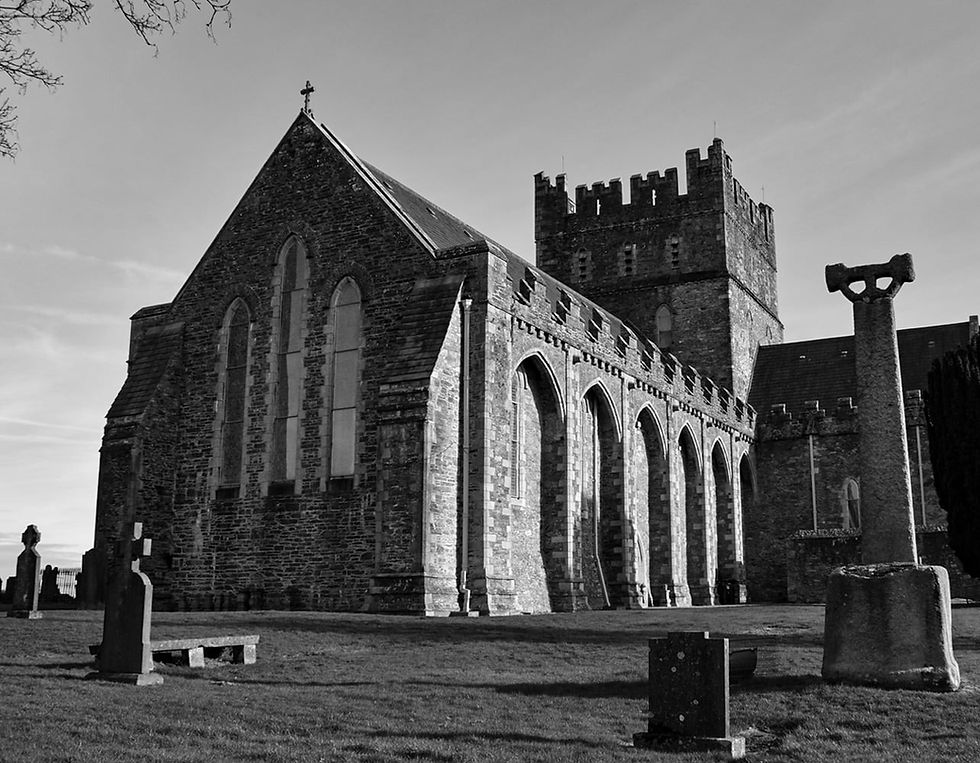Brigid of Kildare
- The heART of Ritual

- Feb 1, 2022
- 3 min read
Updated: Feb 2, 2022

February 1st is celebrated as Lá Féile Bríde (Saint Brigid's Day) in Ireland. St Brigid is the female patron saint of Ireland (together with St. Patrick, whose feast day is March 17th). St Brigid’s Cathedral is one of the oldest (if not the oldest), sites of continuous worship in Ireland. According to the annals, Brigid established her ministry at a place called Druim Criadh (the ridge of clay) around 480AD. It is said she built her church under the branches of a large oak tree that grew on the ridge, in what is now the town of Kildare (from the Irish ‘Cill Dara’ meaning ‘Church of the Oak’).

A Norman cathedral, built in 1223, now occupies the site of the original church of St. Brigid, which according to some, was also the site of an earlier pre-christian shrine to a similarly named Goddess/Deity. The cathedral was built in the early gothic style, with a square central tower, reflecting the structure’s dual purpose as both a place of defence and of religious worship. Falling into disrepair after the dissolution of the monasteries in the 16th Century, It was restored in the 19th Century and continues to undergo further restoration today.
The cathedral houses a collection of stone carvings ranging from early Christian, to Norman and later. One of the finest pieces is the tomb of Bishop Walter Wellesley who died in 1539; carved on the underside of which is a tiny Sheela-na-Gig.

The purpose of these strange carvings of women displaying their genitalia is unknown. Some say the carvings are remnants of a pre-Christian motifs of a fertility or mother goddess, while others argue that they represent the medieval view of female lust as hideous and sinfully corrupting.
The grounds of the cathedral also contain a number of fascinating links to the early history of the site including a Round Tower, Celtic Cross and the supposed remains of St. Brigid’s Fire House/Temple. The Round Tower is one of the finest surviving examples of its type and standing at 33 metres, is the second highest in Ireland. The granite High Cross is missing its top, and because of its lack of decoration, is difficult to date; though presumed to be an early christian artefact.
According to some late-medieval accounts, a perpetual flame was kept in the original oratory at the site. Old sketches do show the ruined gable of a building, but the only remains of it today consist of a small rectangular hollow enclosed by a low, reconstructed rubble wall, with a plaque proclaiming it to be the “Foundations of St. Brigid’s Fire Temple’.
One of the most interesting features of the cathedral is that one of the outside cornerstones has a hole running through it. Known as the wishing stone, it is said that if you can put your arm through the hole and touch your head or shoulder, your prayers to Brigid will be answered.
Within a mile or two of the Cathedral, there are two holy wells dedicated to St Brigid. The first is known as the Garden Well and was built in the 1950’s when the other, much older well (known as the ‘Wayside Well’), could not accommodate the crowds that would gather on St Brigid’s Day and various other holy days.
The Garden Well is a very nice, well kept, serene kind of place. The well is fed by a spring that flows underground before appearing again under a stone archway. The stones below the archway are known as St Brigid's slippers. The stream then flows past a modern bronze statue of Saint Brigid.
The Wayside Well” is a simple, circular stone well, similar in design to many of the older holy wells you’ll find around Ireland. The surrounding trees are still hung with clooties; pieces of cloth which are generally dipped in the water of the well and then tied to a branch while a prayer of supplication is said to its guardian.










